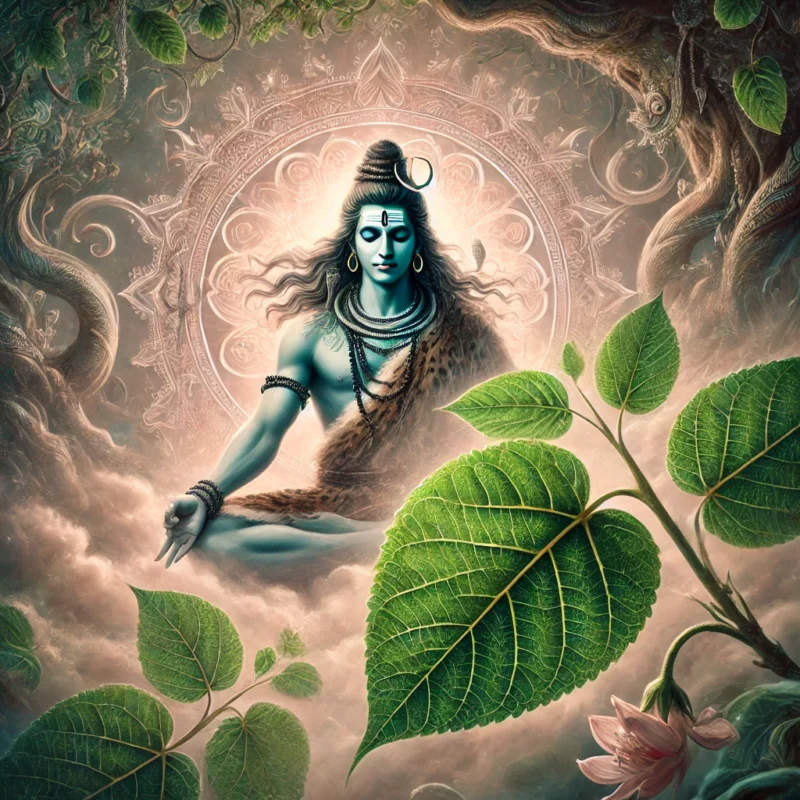Tridalam Trigunakaram Trinetram Cha Tridhayudham. (त्रिदलं त्रिगुणाकारं त्रिनेत्रं च त्रिधायुधम्।)
Trijanma Papanashanam Bilvapatram Shivarpanam. (त्रिजन्मपापसंहारं बिल्वपत्रं शिवार्पणम्॥)
In Sanatan Hinduism, Lord Shiva represents devotion, worship, and the ultimate goal. Known as Mahadev, the God of gods, Shiva embodies mercy and compassion. He is the beginning and the end, the source and the sustenance of creation. Lord Bhole Nath never disappoints his devotees, welcoming the worship and penance of all beings equally—humans, gods, Gandharvas, Kinnaras, demons, Asuras, and Rakshasas alike. Shiva resides in everyone’s heart, and He is pleased with sincere devotion. However, offering items particularly dear to Him, such as Bel Patra (Aegle marmelos), can bring special rewards.
The Significance of the Bel Patra in Hinduism
Bel patra hold a special place in the worship of Lord Shiva. The religious texts describe the profound glory of the leaf:
Akhandai Bilvapatraishcha Pujyai Shiva Shankaram. (अखण्डै बिल्वपत्रैश्च पूज्यै शिव शंकरम्।)
Kotikanya Mahadanam Bilva Patram Shivarpanam. (कोटिकन्या महादानं बिल्व पत्रं शिवार्पणम्॥)
This translates to the belief that offering an unbroken leaf to Shiva is equivalent to offering the greatest charity of a million daughters.
The Ritual of Offering Bel Patra
In Sanatan Hinduism, devotees offer Bel Patra to Lord Shiva with the belief that these leaves absorb the divine energy of Shiva. When offered, a part of this sacred energy is taken home by the devotees, bringing blessings and positivity into their lives. Bathing under the roots of the Bel Patra tree is said to be equivalent to bathing in all the holy waters of the universe, purifying and sanctifying the individual.
Mythological Importance of offering Bel Patra
According to the Shiva Purana, during the churning of the ocean (Samudra Manthan), a deadly poison emerged, threatening the world. To save creation, Lord Shiva consumed the poison, holding it in His throat, which turned His throat blue and increased His body temperature, causing the world to heat up. To alleviate the effects of the poison and cool Shiva, the gods offered him leaves of the ‘Bael tree‘. This act reduced the poison’s impact, leading to the tradition of offering bel patra to Shiva.
Scriptural References to Bel Patra
Bel Patra (leaves of Bael tree) is a trifoliate leaf, symbolizing the three eyes of Lord Brahma, Vishnu, and Mahesh (Shiva). These three eyes represent decision-making, action, and knowledge. The scriptures state that Lord Shiva resides in the Bael tree itself. Bhole Nath cherishes the fruits, flowers, and leaves of this tree. Worshiping the vine tree is believed to remove poverty and bring prosperity. Simply seeing or touching the Bael tree is considered highly meritorious, believed to nullify the fruits of all evil deeds.
Moreover, having a Bael tree at home is said to eliminate negative energy and architectural defects. The fruit of the Bael tree is also considered beneficial for health, adding to the tree’s significance in Hindu tradition.
Bel Patra holds profound significance in Hindu worship, particularly in the devotion to Lord Shiva. By understanding and practicing these rituals, devotees can experience the divine blessings and spiritual upliftment that come from sincere worship. Offering vine leaves to Lord Shiva not only pleases Him but also brings immense spiritual and material benefits to the devotee.
Nagendraharaya Trilochanaya Bhasmangaragay Maheshwaraya.
(नागेन्द्रहाराय त्रिलोचनाय भस्माङ्गरागाय महेश्वराय।)
Nityaya Shuddhaya Digambaraya Tasmai Nakaraaya Namah Shivaya.
(नित्याय शुद्धाय दिगम्बराय तस्मै नकाराय नमः शिवाय।।)







